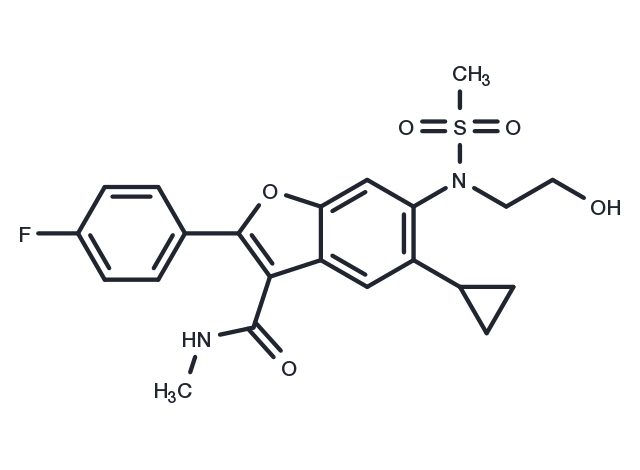keep away from direct sunlight
Powder: -20°C for 3 years | In solvent: -80°C for 1 year

Nesbuvir is a selective hepatitis C virus (HCV) nonstructural protein 5B (NS5B) RNA-dependent polymerase inhibitor.Nesbuvir has an IC50 of 9 nM against hepatocellular carcinoma cells containing 1b HCV replicons.

| Pack Size | Availability | Price/USD | Quantity |
|---|---|---|---|
| 1 mg | In stock | $ 118.00 | |
| 5 mg | In stock | $ 293.00 | |
| 10 mg | In stock | $ 397.00 | |
| 25 mg | In stock | $ 663.00 | |
| 50 mg | In stock | $ 945.00 | |
| 100 mg | In stock | $ 1,280.00 | |
| 500 mg | In stock | $ 2,570.00 | |
| 1 mL * 10 mM (in DMSO) | In stock | $ 323.00 |

| Description | Nesbuvir is a selective hepatitis C virus (HCV) nonstructural protein 5B (NS5B) RNA-dependent polymerase inhibitor.Nesbuvir has an IC50 of 9 nM against hepatocellular carcinoma cells containing 1b HCV replicons. |
| Targets&IC50 | NS3V170A:13 nM (EC50), NS3V170A:9 nM (EC50), NS5BI424V:13 nM (EC50), NS3K583T:15 nM (EC50), NS5B:5 nM |
| In vitro |
Nesbuvir (40 or 80 nM) (approximately 10 and 20 times the EC50 in a 3-day replicon inhibition assay, respectively). The EC50 for Nesbuvir in the transient expression assay is 14 nM, whereas it is 5 nM for the stable replicon.[1] Nesbuvir (0.1 and 1 μM; Huh-7 cells; for 16 days) reduced about 3.6 log10 and 4.2 log10 HCV RNA levels, respectively.[3] |
| In vivo |
Nesbuvir is demonstrated to yield significant antiviral effects in mice with chimeric human livers and in patients infected with HCV.[2] Nesbuvir (chimeric mouse model) treatment resulted in a 2.02 +/- 0.55 log reduction in HCV titer, whereas in combination with interferon using a suboptimal dose of 30 mg/kg three times per day showed a 2.44 log reduction and were better than interferon treatment only.[5] |
| Cell Research | Huh7-BB7 cells are seeded at a density of 20,000 cells per 100 mm dish in DMEM supplemented with 2% FBS, 1 mg/mL G418, and various concentrations of Nesbuvir and/or Boceprevir with DMSO at a final concentration of 0.5% (vol/vol). The medium is removed and is replaced with a fresh medium with the appropriate compound concentrations every 3 or 4 days. After 7 days, the cells are split 1 to 10, placed into fresh 100 mm dishes, and incubated with medium with the appropriate compound concentrations. After 20 days, the medium is removed and the cells are fixed with 7% (wt/vol) formaldehyde and stained with 1% (wt/vol) crystal violet in 50% (vol/vol) ethanol [1]. |
| Synonyms | HCV-796 |
| Molecular Weight | 446.49 |
| Formula | C22H23FN2O5S |
| CAS No. | 691852-58-1 |
keep away from direct sunlight
Powder: -20°C for 3 years | In solvent: -80°C for 1 year
DMSO: 45.0 mg/mL (100.8 mM)
You can also refer to dose conversion for different animals. More
bottom
Please see Inhibitor Handling Instructions for more frequently ask questions. Topics include: how to prepare stock solutions, how to store products, and cautions on cell-based assays & animal experiments, etc.
Nesbuvir 691852-58-1 Microbiology/Virology Proteases/Proteasome HCV Protease HCV-796 HCV 796 HCV796 inhibitor inhibit
